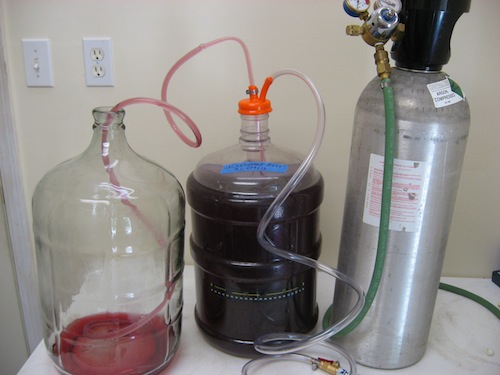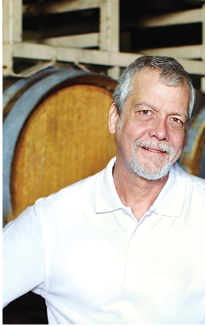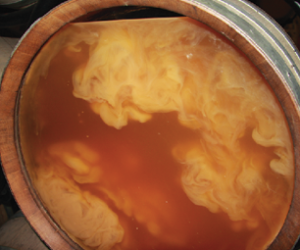
Blanket, flush, sparge, transfer, dispense. To exclude air while doing any of these things to your wine, your best bet is the use of an inert gas. Just about everyone has seen or heard of an inert gas system at a winery, but most home winemakers don’t have one yet. This article presents the basics of the major winemaking gases, along with tips on why they are used, the pros and cons of one gas over another, and how it’s done.
Gases expand to fill any available volume, so discussion of their “weight” or density requires reference to pressure and temperature. One common standard for such comparison is Standard Temperature and Pressure (STP), as defined by IUPAC (the International Union of Pure and Applied Chemistry), a standards-setting body. IUPAC STP is defined as a temperature of 273.15 K (0 °C, 32 °F) and an absolute pressure of 100 kPa (14.504 PSI, 0.986 atm, 1 bar). Unless otherwise noted, all gas densities and volumes in this column are referenced at STP.
The noble gases — helium, neon, argon, krypton, and so on — are inert under almost all conditions. Of these, helium is of little interest to winemakers because it is very light and would quickly dissipate. Of the others, argon has by far the best price because of its relatively high atmospheric abundance (about 0.9%). To call a gas inert, however, requires a reference to the conditions of its use. A gas may be called inert as long as it doesn’t react chemically under a given set of conditions. For winemaking, we may add nitrogen (N2) to the set of inert gases. Nitrogen is very abundant in the atmosphere at nearly 80% by volume, making it available at a favorable price among industrial gases.
Another gas that is often considered “inert” for winemaking is carbon dioxide (CO2). For many wine-related purposes, it is inert and can be used interchangeably with argon or nitrogen. Finally, there is a bit of a hybrid in the group: beer gas. This gas, so called because it is used to serve draft beer “on nitro,” is a mixture of nitrogen and carbon dioxide. Various gas suppliers choose different blends, ranging from 50/50 to 75/25 N2 to CO2. Beer gas delivers some of the characteristics of a completely inert gas like nitrogen, and some of the slightly reactive gas, carbon dioxide.
A note of warning before we proceed: do not use inert gas in a confined space. The very factors that help in winemaking — excluding oxygen and blanketing a space — can be dangerous in your cellar. The gases are colorless and odorless, so ventilation is needed to avoid a high concentration in your work area.
Nitrogen compounds are essential nutrients for yeast in wine fermentation. That nitrogen, though, is already combined with other elements in a chemically reactive form. When we consider gaseous nitrogen, N2, it is much less reactive. The strong triple bond between the two nitrogen atoms make a very stable molecule that resists most ordinary chemical conditions. There are industrial and biological processes for “nitrogen fixation” that break the N≡N triple bond. These processes do not take place in normal winemaking, so we can view nitrogen gas as inert and unreactive. One other significant feature is that it has a gas density of 1.25 g/L. That is near the density of air itself at about 1.29 g/L, so nitrogen will easily disperse in open air. Argon, being one of the noble gases, is monotomic (just an Ar atom) and very unreactive. It is denser than air or nitrogen at about 1.78 g/L. That additional density means that it is more likely to stay in place when spread as a blanketing gas. Carbon dioxide is also denser than air at about 1.98 g/L.
For home use, a typical cylinder for nitrogen or argon is about 2 feet (0.6 m) tall and 8 inches (20 cm) in diameter. Some gas suppliers sell it as a 40 cu. ft. cylinder, representing that as the amount of gas compressed into it when you buy it full (40 cu. ft./1.133 cubic meters/1,133 L). It is filled to over 2000 PSI (pounds per square inch) of pressure. A specific pressure-reducing regulator is needed to dispense the gas. For argon, nitrogen, and beer gas, the designated fitting is a CGA (Compressed Gas Association) #580 connection. That means you may buy a regulator for an argon cylinder and use it for nitrogen or beer gas interchangeably. From the regulator, you need various hoses and valves, depending on your application. The cylinder and regulator are available at welding gas suppliers and the other parts can be found at a good hardware store.
Argon or beer gas are preferred over nitrogen for blanketing a wine tank, carboy, or barrel because of the density difference. More of the gas will remain in contact with the surface of the wine longer, excluding air and the spoilage effects of oxygen. It must be noted, though; that gas is not as effective as a fully topped-up container. In the book Wine Analysis and Production, Bruce W. Zoecklein, et al, state that case very emphatically: “It is universally accepted that there is no better substitute for protection from O2 than storage in completely full containers.” To blanket a primary fermenter with an inert gas cylinder, all you need is a simple valve and hose attached to your regulator. Make sure there is a vent for air to exit the fermenter as you add gas — you do not want to blow up a fermenter! Then insert the end of the hose under or through the lid of the fermenter, set your pressure in the 5–10 PSI range, and open the valve. Flush for several seconds, then turn off the valve. For a narrow-mouth secondary fermenter, place the end of your hose at or just below the wine surface. That way, when you open the valve, the relatively heavier inert gas will be on the bottom of the headspace, forcing the air out the top. Again, do not confine the resulting flow of gas until you are finished flushing the headspace.
Beyond blanketing, the next most popular use for inert gases is flushing or purging (replacing the air in an empty container prior to filling with wine). Carboys, tanks, and bottles all may be flushed before filling. Flushing an empty container may require more gas than expected. According to Zoecklein, reducing the oxygen level from atmospheric levels of about 20% to less than 1% requires about three and one-quarter volume changes in the flushed vessel. For example, an empty 200 L (52 gal) variable capacity tank requires 200 x 3.25 = 650 L of inert gas to flush thoroughly. Since a common compressed gas cylinder contains about 40 cubic feet (1,133 L) of gas, you would only be able to flush the tank twice before needing a refill. Most flushing is done with much less gas, reducing the effectiveness.
Wine may be sparged with inert gas to remove oxygen or CO2. Sparging introduces the inert gas near the bottom of a vessel and allows bubbles to rise through the wine. You may use a fritted stainless steel fitting, a sampling port at the bottom of a tank, or just a plastic hose inserted from the top. As bubbles pass through the wine, dissolved gases will partially transfer from the liquid phase into the gas phase of the bubble. As the bubble of argon or nitrogen leaves the top, it helps take oxygen or carbon dioxide with it. Removing oxygen after air exposure, such as in racking, may help prevent further oxidation. Carbon dioxide may be removed to avoid a “spritzy” character in the wine, especially when attempting to bottle early in the wine’s development. Since some level of dissolved CO2 may be pleasant in a particular wine, it may be preferable to use a nitrogen/ carbon dioxide blend like beer gas to remove oxygen and avoid over-removal of CO2. A winemaker would need to experiment with the various combinations if this was a primary use for an inert gas system. Since the density of the gas is not important for this function, any of these gases will work well.
To transfer wine under an inert gas, it must be in a closed container capable of withstanding the necessary pressure. Manufacturers of glass carboys recommend against pressurizing those containers, leaving the home winemaker with plastic carboys (PET, polyethylene terephthalate) or oak barrels as possible alternatives for a pressurized transfer. A transfer system for plastic carboys may be easily assembled from supplies found at most home winemaking shops. First, cut off the tip of the center connection on an orange two-port carboy cap. Then thread a 24-inch (61-cm) long by 3⁄8-inch diameter racking cane through that opening, arranging it to nearly touch the bottom of the carboy when the cap is snapped on. Attach a length of 3⁄8-inch ID vinyl tubing to the racking cane and drop the end to the bottom of your receiving carboy. Attach a 3⁄8-inch line from the regulator on your inert gas cylinder to the second port on the orange cap.
With everything arranged, start with your regulator knob backed all the way out so no pressure is being delivered. Do not over pressurize the carboy! Open the main cylinder valve, then slowly raise the pressure until the wine begins to flow. Do not exceed 5 PSI. When all the wine has been moved and gas enters the racking cane, turn the flow off and disconnect.
A similar system called the Bulldog Pup is available for barrels on a commercial basis. Operation is similar as the homemade plastic carboy system described above. The Bulldog Pup has a pressure relief valve set at 20 PSI; there should be no need to approach that pressure in normal use. Nitrogen, argon, and beer gas are suitable for pressurized transfer functions.
Finally, you may wish to use argon or nitrogen to dispense your wine. To dispense draft wine from a PET carboy, set up the transfer system described above. In the end of the 3⁄8-inch dispensing hose, insert a plastic thumb-tap faucet. For white or rosé wine, place the carboy in a refrigerator for cold by-the-glass wine any time. For red, you can just leave the carboy (and gas cylinder) on the kitchen counter and dispense glasses of red as needed (160 4-ounce pours from a 5-gallon/19-L carboy!).
Instead of the carboy system, you could use a 5-gallon (19-L) stainless steel soda syrup keg like those used for draft beer. That leads to further discussion of carbon dioxide, so we will start over with blanket, flush, sparge, transfer, and dispense. Carbon dioxide is unusual among commercial compressed gases in that it liquefies at a relatively low pressure — a few hundred PSI, depending on temperature. So instead of a highly pressurized gas in a cylinder, you purchase a pressurized condensed liquid in a cylinder. Rather than referring to cubic feet of contained gas, the cylinders are sized by pounds of CO2 liquid contained. For home use, a small cylinder about 18 inches (46 cm) long by 5 inches (13 cm) in diameter holds five pounds of CO2. In addition to a full cylinder, you will need a CO2 regulator. This gas uses a CGA #320 fitting that is not interchangeable with nitrogen, argon, or beer gas. In service, the cylinder must be kept upright to dispense gaseous CO2 from the headspace of the tank. If liquid CO2 enters the regulator, it will be damaged by the sudden expansion of the gas.
Carbon dioxide is unique among gases in its chemical behavior as well. While considered “inert” for some winemaking purposes, it actually undergoes a transformation in water (or wine). As CO2 dissolves in water, some water molecules dissociate and interact with the gas molecules:
CO2 + H2O → H+ + HCO3–
As you will note, the reaction products include the presence hydrogen ion, H+. That, of course, is the marker for an acid solution and carbon dioxide is sometimes called carbonic acid when dissolved in water.
It is the reverse of this reaction, ions combining to form molecular CO2, that allows for the relatively slow bubbling of a carbonated beverage. By comparison, a completely inert gas such as nitrogen or argon will quickly bubble out of solution, leaving it flat. For some wine applications (as in sparkling wine), a high concentration of CO2 is desirable. Sometimes a moderate level of dissolved CO2 will provide a pleasant “lift” or brightness to the wine, even to the point of very light carbonation known as “petillant” or “crackling.” For still wines, however, only modest levels of CO2 are desirable and most of the gas from fermentation escapes in the months of aging prior to bottling. If you use carbon dioxide as your cellar “inert gas,” you may reintroduce an undesirably high level of dissolved CO2.
Blanketing a cold soak with carbon dioxide is very common and offers no risk to the wine from excess CO2. It is usually introduced as a solid (dry ice) rather than as gas from a cylinder. If you cover a primary fermenter after adding dry ice to cool the must, you will automatically get a blanketing effect from the evaporating CO2. If the dry ice all evaporates, you may wish to add CO2 in the same manner described above for nitrogen or argon.
Flushing a tank with CO2 works just like with nitrogen or argon and requires a fairly large number of volume changes to eliminate oxygen. One pound of liquid CO2 expands to about 250 L (66 gal) under standard conditions; so flushing that 200 L (53 gal) tank with 650 L (172 gal) of gas would take about 2.6 lbs. (1.18 kg) of your 5-lb (2.27-kg) cylinder.
Dispensing may offer a unique advantage with CO2: Draft sparkling wine. For this use, you will want that 5-gallon (19-L) soda syrup keg mentioned earlier. Rack in your wine, flush the headspace with CO2, and chill the keg. Turn on the gas at 10 to 15 PSI and rock the keg to distribute the gas. When you hear it stop bubbling, you have carbonated wine. Keep it refrigerated and dispense with a conventional draft beer faucet. If you do not want your wine carbonated, you cannot dispense it with CO2. Back to argon or nitrogen.
While I have had a CO2 system for draft beer for several years and have worked with the other inert gases in a laboratory setting, I am fairly new to argon in the home cellar. To help me with my system, I contacted Bob Rue, who is retired from a 47-year career at Air Gas, a major supplier of industrial gases, and now is the owner and winemaker at Robert Rue Vineyard. I am grateful for his help on this article.
A new “40 cubic foot” cylinder of beer gas costs about $175, nitrogen about $180, and argon about $215. For a refill, nitrogen is about $30, beer gas about $45, and argon about $60. Most welding gas suppliers want to handle the “refill” on an exchange basis. A 5-pound (2.27-kg) CO2 cylinder costs about $100 and a refill is about $25. Since five pounds (2.27 kg) will produce about 44 cubic feet (1.25 cubic meters), it comes in a bit below the cost of nitrogen or beer gas and well under argon.
For any gas, you will need a regulator to get it out of the cylinder. I recommend a dual-gauge regulator, which allows you to monitor the residual pressure in the cylinder as well as the delivery pressure. A regulator costs between $75 and $125 and will be specific for either high-pressure inert gases (argon, nitrogen, beer gas) or for carbon dioxide.
Beyond these basics, you can configure your system with valves, hoses, quick disconnects, or dispensing nozzles from the hardware store. Go to the “pneumatic tools” wall and you will find all kinds of clever bits. A simple coiled hose and trigger-equipped blow gun for dispensing gas costs about $15 each. For racking or dispensing, you will be using typical homebrew equipment. A used soda syrup keg is about $70 and a new one is about $150.
The choice is yours. Carbon dioxide is the least expensive “inert” gas, but may carbonate your wine. Nitrogen is more inert and costs less than argon, but easily disperses in air. Argon is the most expensive, but also provides a better blanket than nitrogen. Beer gas represents a good compromise of cost and blanketing, but you would not want to store your wine in a pressurized keg under it. Whatever you choose, you are on your way to more efficient and effective techniques for producing better wine.







